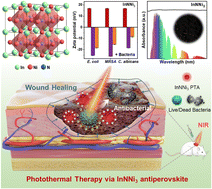Clinical treatment of open wounds is challenging due to bacterial infection and biofilm protection. Antibiotics are commonly utilized as antibacterials; however, multidrug resistance (MDR) severely affects the therapeutic effect. Therefore, developing a non-antibiotic strategy for treating infections and accelerating wound healing is highly required. Herein, for the first time, an electronically inverted antiperovskite, InNNi3, has been demonstrated as a novel photothermal material with efficient and broad-spectrum anti-bacterial activity. Due to the quasi-continuous energy levels and inverse coordination with cations/anions exchanged in crystal sites, InNNi3 possesses a near-unity photothermal conversion efficiency (96.9%) and a positively charged surface, which together contribute to the high antimicrobial activity (99.9%) via photothermal activation and electrostatic interaction with pathogens, including methicillin-resistant Staphylococcus aureus (MRSA), Escherichia coli (E. coli) and Candida albicans (C. albicans) within several minutes. Moreover, as an effective antibiofilm agent, InNNi3 exhibits over 99% scavenging effect on biofilms. An accelerated healing rate for infected wounds has also been achieved using an InNNi3-treatment strategy under NIR irradiation by reducing inflammation, promoting collagen deposition, boosting early expression of CD31 and facilitating the regeneration of dermis and skin appendages. The excellent biocompatibility of InNNi3 further demonstrates its great potential for clinical applications in future.


